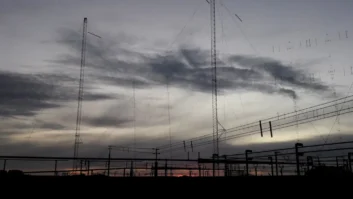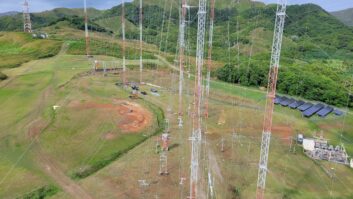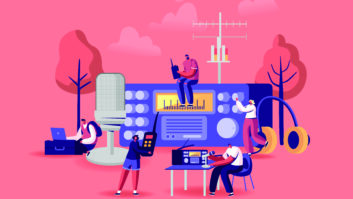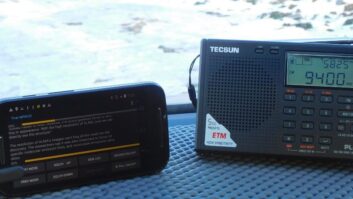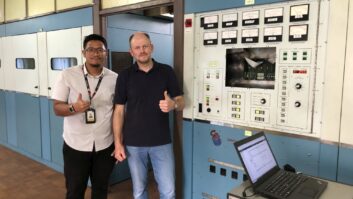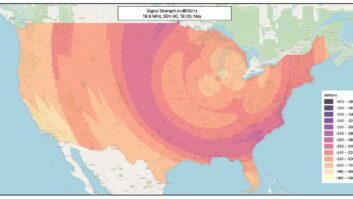OTTAWA, Ontario — “6-7-9-2-6. 5-6-9-9-0.” Tune across the shortwave bands (above AM/MW), and chances are you will come across a “numbers station.” There’s no programming to speak of; just a mechanical-sounding voice (male or female) methodically announcing seemingly random groups of single digit numbers for minutes on end.

The site of British intelligence’s numbers station transmitter site, “The Lincolnshire Poacher,” at the RAF base in Akrotiri, Cyprus.
Credit: Lewis Bush, ”Shadows of the State.”
Congratulations! You are now officially a spy-catcher, to the extent that you may have tuned into a spy agency’s “numbers station” transmitting one-way instructions to their minions worldwide.
Numbers stations are unidentified radio broadcasts that consist usually of a mechanical voice “reading out strings of seemingly random numbers,” explained Lewis Bush, author of “Shadows of the State” a new history of numbers stations and the spies who run them. “These are sometimes accompanied by music, tones or other sound effects.” He said. “There are also related stations broadcasting in Morse Code and digital modes.”
NO PARANOID DELUSION
Program formats aside, the common purpose of numbers stations is “to broadcast coded messages to spies in distant countries,” said Ryan Schaum. He is co-founder of Numbers Station Research and Information Center (NSRIC), a hobbyist group that reports on these signals atwww.numbers-stations.com. According to Schaum, the “use of shortwave allows complete secrecy and makes it impossible to determine who the recipient is.”
In order to decode the message hidden within the numbers broadcast, “the recipient uses ‘one-time pad’ encryption, which cannot be decoded by anyone without the time pad key,” said Schaum. Printed on paper pads, the one-time pad key allows the recipient to decode the message just once, it is then discarded for a fresh key after every use, thus making the cipher literally unbreakable. “For these reasons, numbers stations are still used today.”

A waveform file of “The Lincolnshire Poacher” numbers station broadcast.
Credit: Lewis Bush, “Shadows of the State.”
The notion that spy agencies are contacting spies using code broadcasts over shortwave may seem like a paranoid delusion. But as the saying goes, “just because you’re paranoid doesn’t mean they’re not out to get you.”
In the case of numbers stations and the evidence associated with them, “the most widely agreed upon theory is that they are operated by intelligence agencies,” said Bush. “This theory has been backed up by a number of cases where spies have been uncovered or arrested in the act of listening to or decoding these stations, and in a few rarer cases by declassified documents and government admissions of ownership.”
“Voice (numbers) stations are known to be spy messages,” said Paul Beaumont. He is an associate editor of Eye Spy Intelligence Magazine, an independent publication dedicated to espionage and intelligence. “For instance, V02 in Spanish was used to instruct Ana Belen Montes,” Beaumont said.
Montes was a United States Defense Intelligence Agency employee who spied for Cuba from 1985 until caught by the FBI in 2001. A 2016 report by CNN’s Thom Patterson described Monte as “The most dangerous U.S. spy you’ve never heard of.”

One of Ana Belen Monte’s notes used for decoding messages from her Cuban handlers.
Credit: Wiki Commons
A CENTURY OF SPY RADIO
Motivated by what she saw as the U.S.’ unfair policy toward Cuba, Montes avoided detection by never removing top-secret documents from the DIA. Instead, this spy memorized what documents she could at work, and then transcribed these memories on her laptop at home.
Next, she would receive coded instructions from Cuban numbers station V02 (via shortwave radio) “about where to hand over the discs to her Cuban contacts,” Patterson wrote. “Some of the most damaging information Montes admitted giving to Cuba, the FBI said, were the identities of four American undercover intelligence officers working there.”
Today’s shortwave numbers stations are very much a legacy of the Cold War. The fierce espionage battles between the West and the Soviet Bloc — and their mutual vigilance in ferreting out each other’s concealed agents — required a form of communications that covered long distances, provided ironclad security, and yet could be received using locally available radios if need be. Numbers broadcasts via shortwave fit the bill perfectly.
Yet the legacy of using radio to transmit secret information goes back to the First World War. According to Māris Goldmanis, a numbers station listener and NSRIC member based in Riga, Latvia, Allied numbers stations broadcasting in Morse Code were detected by Austrian Archduke Anton Habsburg.
“He was a radio enthusiast, and as a member of the royal family received permission to construct his own radio receiver,” said Goldmanis. “His first activities involving listening to numbers stations such as FL ‘Tour Eiffel’ from Paris, ICI from Cortona [Italy], and FSK from Moscow.”
“The reason coded broadcasts started in World War I was not on a whim,” said Beaumont. “The British had dredged up the underwater telegraphic cables used by Germany and its allies and cut them, forcing the use of radio to send messages.”

A one-time pad used by the CIA.
Credit: Wiki Commons
FAMOUS STATIONS
Radio as an espionage tool exploded during World War II, and, after that, the Cold War. This is when numbers stations came into their own, as spy agencies such as the CIA, Britain’s MI6, and the Soviet Union’s KGB spent millions building and operating high-powered yet clandestine shortwave transmitter sites.
One of the “best known” numbers stations was “The Lincolnshire Poacher,” due to its use of “The Lincolnshire Poacher” folk song played on a pipe organ as an identifying signal. Amateur radio enthusiasts used direction-finding equipment to locate this station’s transmission location to the RAF base in Akrotiri, Cyprus. This station is believed to have been operated by MI6 from the mid-1970s to 2008, using several curtain-array shortwave antennas.
“Among the historic ones which no longer broadcast, there are many stations which could be considered weird,” noted Bush. “One known as the Swedish Rhapsody could be a strong contender, as it used music played on a child’s music box and the voice that read its numbers sounded somewhat like a child; characteristics which made the station particularly eerie.” This numbers station is believed to have broadcast from a transmission site in Falenty, Poland.
Even after the Cold War, numbers stations have stayed in business. One of these is “HM01, which is thought to be Cuban operated,” said Bush. “It transmits voice read numbers in combination with digital transmissions using the Redundant Digital File Transfer mode. Another example is a station known as XPA, which is believed to be run by one of the Russian intelligence agencies and transmits numbers solely using multiple-frequency key shifting.”
Even North Korea has apparently gone into the spy station business, with one key difference. The dictatorship’s domestic radio service KCBS Pyongyang Pangsong has been noted to sometimes transmit ‘maths lessons,’ which it has been suggested are in fact numbers messages,” Bush said. Whether they are intended for real agents or are simply intended to unnerve South Korea and its allies is unclear. According to Beaumont, this numbers station is known as V15, and “decoded sheets [associated with tuning to its signals] have been recovered.”

The speculated transmission site of “The Swedish Rhapsody” numbers station in Falenty, Poland.
Credit: Lewis Bush, “Shadows of the State.”
TODAY
Today, numbers stations remain a reality on shortwave radio, even in the Internet Age. The reason for these stations’ longevity isn’t hard to understand. Unlike communications over the internet that leave digital evidence (even in supposedly secure systems) for investigators to find, receiving instructions via shortwave numbers broadcasts leave no traces behind.
“It’s a rather safe way to send coded messages, unless you are observed listening to them,” said Goldmanis. “You don’t need a large clunky radio. It’s even possible to listen these stations on the internet using remote software defined radio, and that is what we hobbyists do.”
This doesn’t mean that receiving instructions via numbers stations is a perfect form of communications for spies, because it isn’t. Spies can get caught if the authorities see them listening to numbers broadcasts, as has occasionally happened.
“A Cuban Morse numbers station — M08a — was also cited in an FBI affidavit as being the channel for a husband and wife team, the Myers, who were arrested following shoddy operator discipline,” said Beaumont. “I think they used the internet and made reference to a received Morse transmission.”
Nevertheless, the numbers station’s ability to send secret information securely over large areas means that this form of shortwave communication likely has a secure future; even while other forms of analog broadcast are being supplanted by digital means.
For readers who are now wishing to tune into numbers stations, making your first direct contact with spycraft is easy. Just get a shortwave radio and scan around the dial. You can even tune in using a remote-controlled shortwave radio over the web, at the free site www.globaltuners.com.
To save time, check out a website like www.hfunderground.com to find numbers stations to tune into. Another good bet for frequencies and general information is the United Kingdom’s ENIGMA 2000 [European Numbers Information Gathering & Monitoring Association] at www.apul64.dsl.pipex.com/enigma2000.
A third option is to go to NSRIC’s at www.numbers-stations.com or http://priyom.org, and tap into its archived and live numbers stations feeds.
Be warned: After hearing your first numbers station, your personal experience of espionage will move from fiction to nonfiction. The spies are out there, they are broadcasting, and you will have heard them!
James Careless reports on the industry for Radio World from Ottawa, Ontario.





